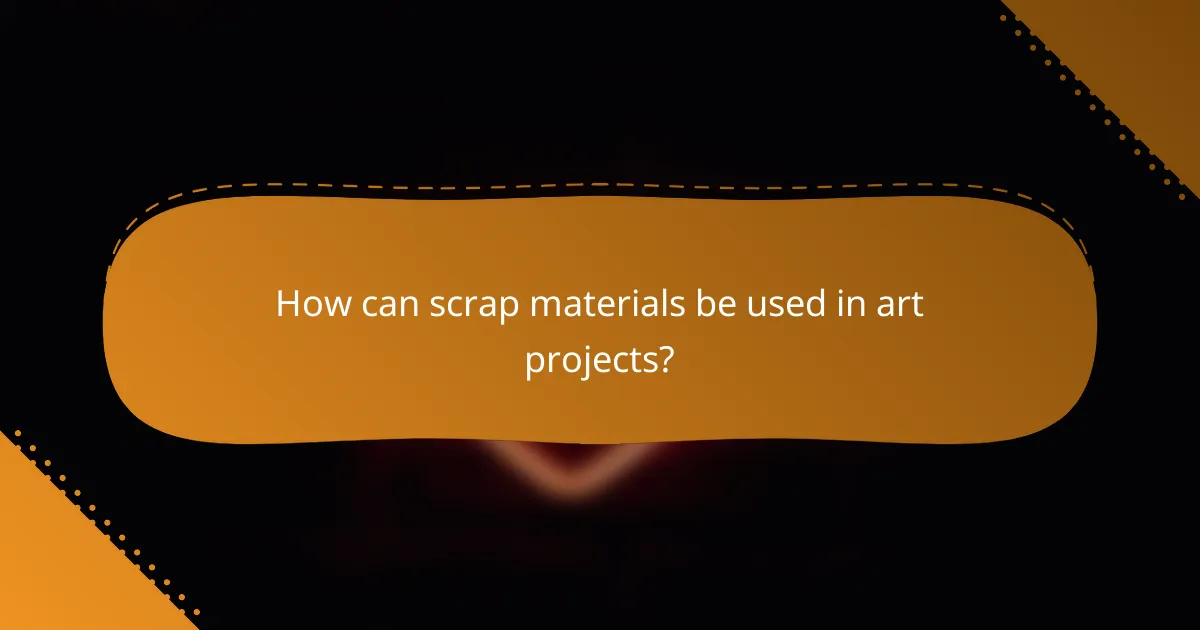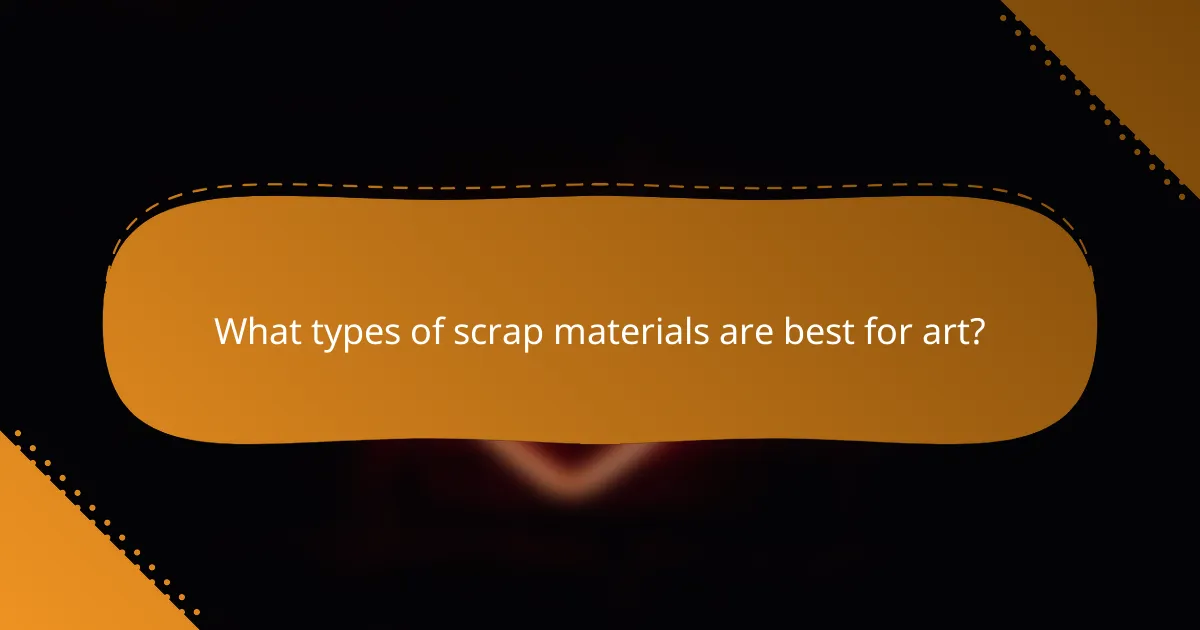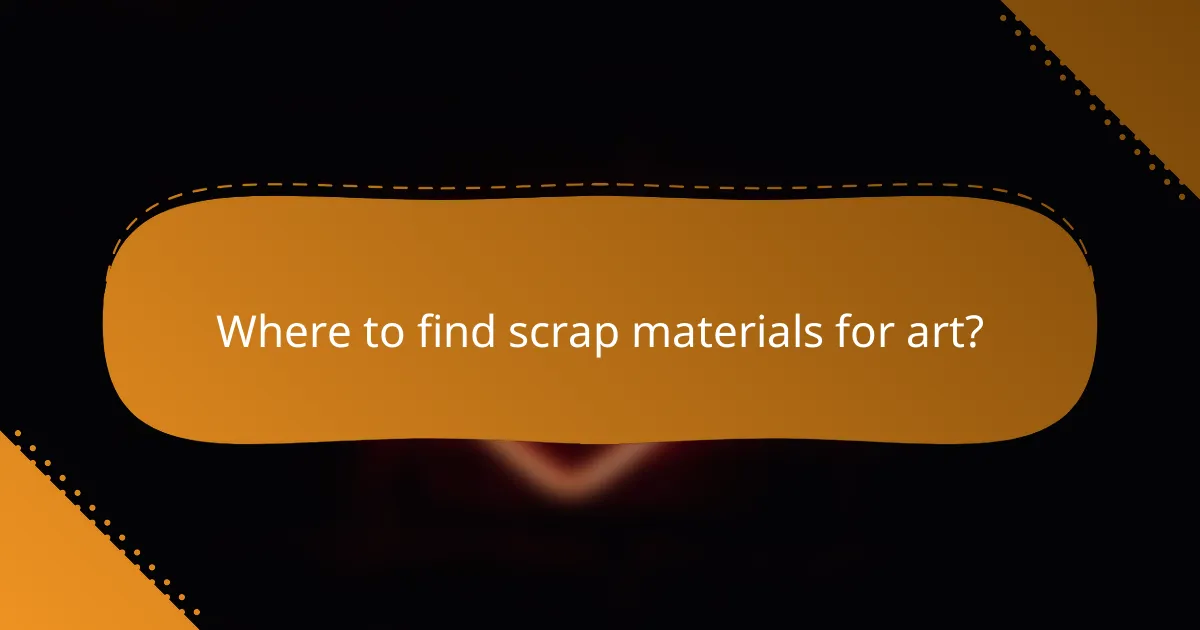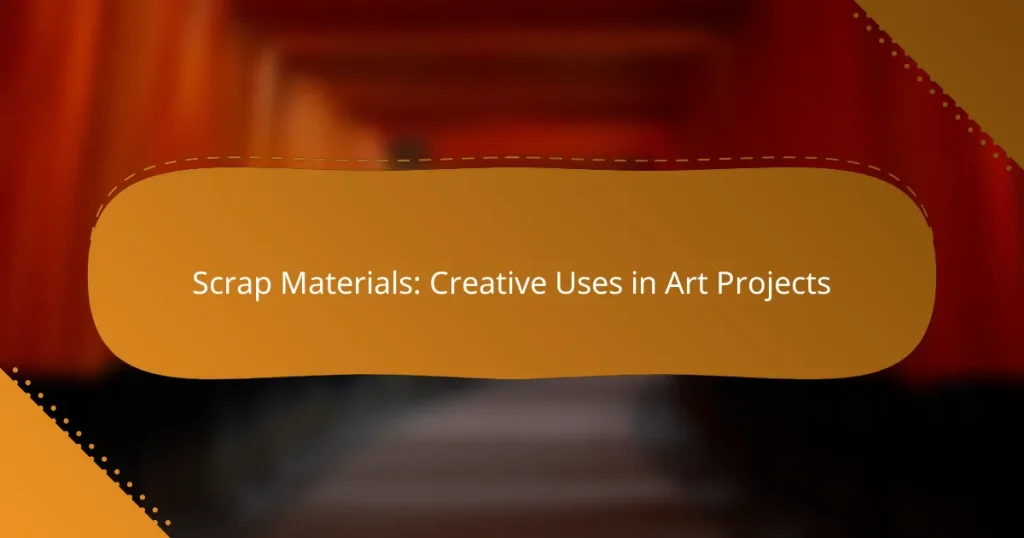Scrap materials offer a wealth of creative possibilities for art projects, allowing artists to transform discarded items into unique works of art. By repurposing materials such as wood, metal, plastic, glass, and fabric, creators can not only express their artistic vision but also promote sustainability and environmental awareness.

How can scrap materials be used in art projects?
Scrap materials can be creatively repurposed in art projects to produce unique and sustainable works. Artists often utilize discarded items to express their creativity while promoting environmental awareness.
Upcycled sculptures
Upcycled sculptures transform waste materials into three-dimensional art pieces. Common materials include wood scraps, metal pieces, and plastic containers. Artists can assemble these items using adhesives, welding, or mechanical fasteners to create visually striking forms.
Consider the weight and durability of materials when designing your sculpture. For instance, heavier items may require a sturdy base to ensure stability. Start with a clear concept and sketch your design before gathering materials.
Mixed media collages
Mixed media collages combine various materials, such as paper, fabric, and found objects, to create layered artwork. Artists can incorporate scrap paper, old magazines, and fabric remnants to add texture and depth to their pieces.
To begin, select a base like canvas or cardboard and gather your scrap materials. Experiment with different arrangements before adhering items down. Use mod podge or glue to secure your collage, and consider finishing with a protective sealant for longevity.
Functional art pieces
Functional art pieces serve a practical purpose while showcasing artistic expression. Items like furniture, lighting fixtures, or home decor can be crafted from scrap materials, blending utility with creativity.
When designing functional art, prioritize safety and usability. For example, ensure that any furniture made from scrap wood is sturdy and well-finished to avoid splinters. Think about how the piece will fit into a space and its intended use.
Textile art from fabric scraps
Textile art utilizes fabric scraps to create quilts, wall hangings, or soft sculptures. Artists can sew, weave, or knot various fabric pieces together, allowing for vibrant patterns and textures.
Start by collecting a variety of fabric scraps in different colors and patterns. Consider using a sewing machine for larger projects or hand-stitching for smaller pieces. Experiment with techniques like patchwork or appliqué to enhance your textile art.
Jewelry made from metal scraps
Jewelry made from metal scraps can be both stylish and eco-friendly. Artists often use discarded metal pieces, such as old jewelry, tools, or cans, to create unique accessories like earrings, necklaces, and bracelets.
When crafting metal jewelry, ensure that edges are smoothed to prevent injury. Use pliers and wire to assemble pieces, and consider adding beads or other embellishments for added flair. Research local regulations regarding metalworking if you plan to sell your creations.

What types of scrap materials are best for art?
Various scrap materials can be creatively repurposed for art projects, including wood, metal, plastic, glass, and fabric. Each type offers unique textures, colors, and structural possibilities that can enhance artistic expression.
Wood scraps
Wood scraps are versatile and can be used for a variety of art projects, from sculptures to wall art. Common sources include leftover pieces from furniture or construction, which can be cut, painted, or assembled into new forms.
When working with wood, consider the type of wood and its finish. Softwoods like pine are easier to cut and shape, while hardwoods like oak provide durability. Always sand rough edges to prevent splinters.
Metal pieces
Metal pieces can add an industrial flair to art projects. Sources include discarded cans, old tools, or scrap metal from workshops. These materials can be welded, soldered, or simply glued together to create striking designs.
Be cautious with sharp edges and rust; wear gloves when handling metal scraps. Consider using non-toxic paints or finishes to enhance the appearance while ensuring safety.
Plastic containers
Plastic containers, such as bottles and food packaging, are lightweight and easy to manipulate for various art forms. They can be cut, painted, or transformed into 3D sculptures or functional art pieces.
When using plastic, be mindful of recycling codes. Some plastics can be harmful when heated or melted, so avoid high-temperature applications. Instead, focus on cold assembly techniques like gluing or tying.
Glass bottles
Glass bottles can be creatively reused in art, offering a range of colors and shapes. They can be transformed into vases, lanterns, or even mosaic pieces when broken safely.
Always handle glass with care to avoid injury. Use protective gear when cutting or breaking glass, and consider using a glass cutter for clean edges. Upcycling glass can also contribute to sustainability efforts.
Fabric remnants
Fabric remnants from old clothes or upholstery can be used in textile art, patchwork, or mixed media projects. These scraps can add color, texture, and pattern to your creations.
When working with fabric, consider the type of fabric and its properties. Natural fibers like cotton are easier to sew, while synthetics may require special techniques. Use fabric glue for quick projects or sewing for more durability.

Where to find scrap materials for art?
Finding scrap materials for art projects can be both economical and environmentally friendly. Various local sources provide a wealth of materials that can be repurposed creatively.
Local recycling centers
Local recycling centers are excellent places to find scrap materials for art. They often have a variety of items, including paper, cardboard, plastics, and metals, which can be transformed into unique art pieces. Check with your local center about their policies on picking up materials or any fees that may apply.
Many recycling centers also host events or workshops that encourage creative reuse, providing inspiration and additional resources for artists. It’s advisable to visit regularly, as inventory can change frequently.
Thrift stores
Thrift stores are treasure troves for artists seeking scrap materials. You can find a wide range of items such as old clothing, furniture, and household goods that can be repurposed. Prices are typically low, making it easy to experiment without a significant financial commitment.
When shopping at thrift stores, look for items that can be easily disassembled or altered. Keep an eye out for seasonal sales, as many stores offer discounts that can make your finds even more affordable.
Construction sites
Construction sites can be a rich source of scrap materials, including wood, metal, and various building supplies. However, it’s essential to seek permission before taking anything, as materials are often considered property of the contractor. Some sites may even have designated areas for scrap that they are willing to give away.
Be cautious and ensure safety when exploring construction sites. Always wear appropriate gear and follow any site regulations to avoid accidents or legal issues.
Community swap events
Community swap events are fantastic opportunities to acquire scrap materials while connecting with fellow artists. These events allow individuals to trade items they no longer need for materials that can be used in art projects. They often feature a variety of goods, from fabric to tools.
Participating in these events can also foster a sense of community and collaboration among artists. Keep an eye on local community boards or social media groups to find upcoming swap events in your area.

What are the benefits of using scrap materials in art?
Using scrap materials in art offers numerous advantages, including promoting environmental sustainability, reducing costs, and fostering creativity. Artists can transform discarded items into unique pieces, contributing to a more sustainable practice while exploring innovative ideas.
Environmental sustainability
Incorporating scrap materials into art projects significantly reduces waste and minimizes the demand for new resources. By repurposing items that would otherwise end up in landfills, artists help decrease their environmental footprint.
Common scrap materials include old newspapers, plastic bottles, and metal scraps. Using these items not only conserves natural resources but also encourages a culture of recycling and responsible consumption.
Cost-effectiveness
Creating art with scrap materials can be a cost-effective solution for artists, especially those on a budget. Instead of purchasing expensive supplies, artists can source free or low-cost materials from their surroundings.
Local community centers, schools, and even friends can be excellent sources for scrap materials. This approach allows artists to allocate their budgets to other aspects of their projects, such as tools or exhibition costs.
Encouragement of creativity
Using scrap materials challenges artists to think outside the box and develop innovative solutions. The limitations of working with available materials can spark new ideas and techniques that may not arise when using traditional art supplies.
For instance, an artist might use a broken chair to create a sculpture or transform fabric scraps into a vibrant collage. This creative process not only enhances artistic skills but also promotes resourcefulness and adaptability in art-making.


